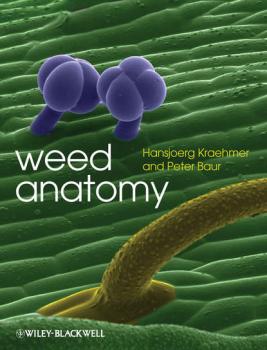Hansjoerg Kraehmer
Список книг автора Hansjoerg KraehmerWeed Anatomy
Weeds affect everyone in the world by reducing crop yield and crop quality, delaying or interfering with harvesting, interfering with animal feeding (including poisoning), reducing animal health, preventing water flow, as plant parasites, etc. Weeds are common everywhere and cause many $ billions worth of crop losses annually, with the global cost of controlling weeds running into $ billions. The anatomy of plants is generally well understood, but the examples used for explanations in most books are often restricted to non-weed species. Weeds have many features that make them more competitive, for example enabling them to more quickly recover after herbicide treatment. Some of these adaptations include rhizomes, adapted roots, tubers and other special structures. Until now, no single book has concentrated on weeds’ anatomical features. A comprehensive understanding of these features is, however, often imperative to the successful implementation of many weed control measures. Beautifully and comprehensively illustrated, in full colour throughout, Weed Anatomy provides a comprehensive insight into the anatomy of the globally-important weeds of commercial significance. Commencing with a general overview of anatomy, the major part of the book then includes sections covering monocotyledons, dicotyledons, brackens and horsetails, with special reference to their anatomy. Ecological and evolutionary aspects of weeds are also covered and a number of less common weeds such as Adonis vernalis, Caucalis platycarpos and Scandix pecten-veneris are also included. The authors of this book, who have between them many years of experience studying weeds, have put together a true landmark publication, providing a huge wealth of commercially-important information. Weed scientists, plant anatomists and agricultural scientists, including personnel within the agrochemical and crop protection industry, will find a great deal of useful information within the book’s covers. All libraries in universities and research establishments where agricultural and biological sciences are studied and taught should have copies of this exceptional book on their shelves.
Atlas of Weed Mapping
Weeds are variously defined as plants growing where they are not wanted, plants that interfere with human activity. Weeds affect everyone in the world by reducing crop yield and quality, delaying or interfering with harvesting, interfering with animal feeding, reducing animal health, preventing water flow, as plant parasites, etc. It is estimated that those problems cause $ billions worth of crop losses annually and the global cost of controlling weeds also runs into many $ billions every year. Atlas of Weed Mapping presents an introductory overview on the occurrence of the most common weeds of the world. The book notably includes: Description of cropping practices and explanations for the global distribution of weeds Invasive plant mapping Aquatics and wetland plants with histological plant details Theoretical and practical aspects of weed mapping Aspects on the documentation of herbicide resistance Biodiversity, rare weeds and the dominance of the most common weeds Fully illustrated with more than 800 coloured figures and a number of tables, this new characterisation of anthropogenic vegetation will be interesting for readers of a great number of disciplines such as agriculture, botany, ecology, geobotany and plant community research. More than a hundred experts have contributed data to this unique compilation.

